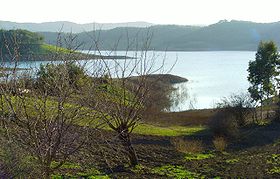36°59′18″N 35°20′5″E / 36.98833°N 35.33472°E
| Seyhan Sarus | |
|---|---|
 Seyhan River flowing through Adana | |
 | |
| Native name |
|
| Location | |
| Country | Turkey |
| Provinces | Kayseri, Adana, Mersin |
| Districts | Aladağ, Karaisalı, Çukurova, Sarıçam, Seyhan, Yüreğir, Tarsus |
| Towns/Cities | Adana, ancient Augusta |
| Physical characteristics | |
| Source | Akinek Dağı |
| • location | Aladağ, Adana, Turkey |
| • elevation | 1,500 m (4,900 ft) |
| Mouth | Cape Deli, Mediterranean Sea |
• location | Tarsus, Mersin, Turkey |
| Length | 560 km (350 mi) |
| Basin size | 20,450 km2 (7,900 sq mi)[1] |
| Basin features | |
| Tributaries | |
| • left | Zamantı |
The Seyhan River (formerly written Seihan, Sihun; ancient name: Ancient Greek: Σάρος, Sáros), alternatively known as Sarus (or in Turkish as Sarus Su),[2] is the longest river of Cilicia and the longest of Turkey that flows into the Mediterranean Sea. The river is 560 kilometres (350 mi) long and flows southwest from its headwaters in the Tahtalı-Mountains (in Sivas and Kayseri provinces) in the Anti-Taurus Mountains to the Mediterranean Sea via a broad delta. Its main tributaries are Zamantı and Göksu, which unite in Aladağ, Adana to form the Seyhan River. The Zamantı River originates from the Uzun Plateau in Pınarbaşı, Kayseri and crosses Tomarza, Develi and Yahyalı districts in Kayseri.
Its sources were reported being in the Taurus Mountains in Cataonia. It flowed through Cappadocia by the town of Comana, then through Cilicia. It is noted by numerous ancient authors including Livy,[3] Xenophon,[4] Procopius,[5] Strabo,[6] Ptolemy,[7] Appian,[8] Pliny the Elder,[9] and Eustathius of Thessalonica who erroneously calls it Sinarus.[10]
50 kilometres (31 mi) from its mouth, Seyhan River flows through the city of Adana, the only settlement situated on the river. Several bridges and footbridges cross the river in Adana including the Stone Bridge, a 2nd-century Roman bridge. Ancient city of Augusta was also situated on the river, corresponding today to the east side of the Çatalan reservoir. The river meets the Mediterranean Sea at Cape Deli.
- ^ Akbulut, Nuray; Bayarı, Serdar; Akbulut, Aydin; Şahin, Yalçın (2009). Rivers of Europe. pp. 643–672. ISBN 9780081026120.
- ^ John Garstang and O.R. Gurney The Geography of the Hittite Empire (1959), p. 51, at Google Books
- ^ Livy. Ab urbe condita Libri [History of Rome]. Vol. 33.41.
- ^ Xenophon, Anabasis 1.4.1.
- ^ Procopius, de Aedif. 5.4.
- ^ Strabo. Geographica. Vol. xii. p. 535. Page numbers refer to those of Isaac Casaubon's edition.
- ^ Ptolemy. The Geography. Vol. 5.8.4.
- ^ Appian Syr. 4.
- ^ Pliny. Naturalis Historia. Vol. 6.3.
- ^ Eustathius of Thessalonica, ad Dion. Per. 867.